News: Front Mission Evolved Screenshots
Posted on : 19-03-2010 | By : Cacophanus | In : News
Hardware: PlayStation 3, Xbox 360
19
A bunch of new screenshots for Front Mission Evolved have been going the rounds, coupled with the semi-updated dev diaries we clearly have a PR campaign in its latter stages on our hands. Admittedly, there are still no actual release dates as yet but with box shots getting previewed it’s obvious we have a release fairly imminent. Naturally, we’ll be the reviewing the game once its out – so keep an eye out for that. In any case, we’ve linked the other screenshots below and whilst they show the game has come along a fair bit, they still don’t look that amazing really. Anyway, see what you think.
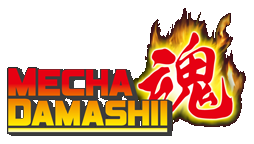
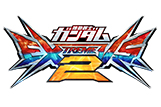
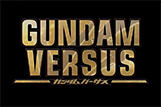
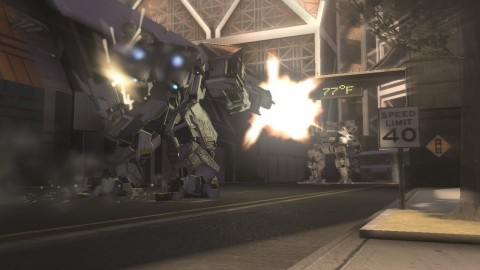
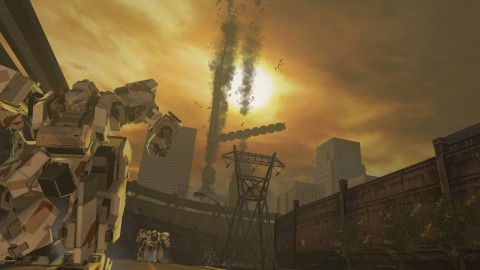
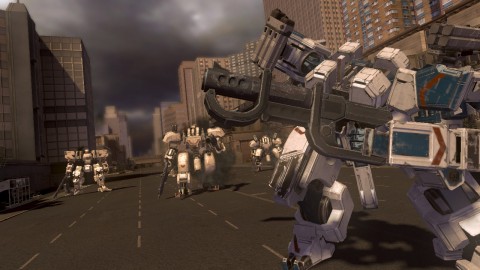
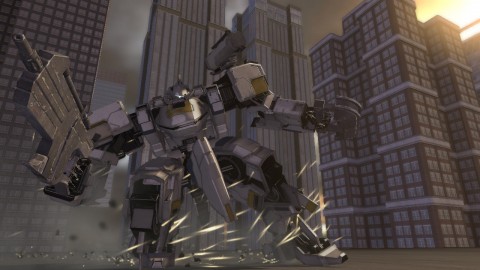








While western developers may not understand how to make a quality mech game just yet, I feel tasking them with such a game trains them to think outside of the box in certain capacities. Down the road, all of the staff who worked on a game such as Front Mission Evolved, may take their experience and apply that to another game. Thus systematically improving the state of western game development abroad over time. The biggest problem, as you yourself stated in the past Cacophanus, is that the west tends to mold large mechanized machines as allegories for the human form. ‘Robots’ are all too often treated as just skins on top of an otherwise human mimicking bone structure. So here, developers at Double Helix working with Evolved are forced to break free from this norm in order to try (with the best of their ability) to live up to such a well respected Japanese mech franchise.
So whether Front Mission Evolved succeeds or not, this is one positive I can pull from the games existance. (By suceeds I mean the quality of the game itself rather than sales).
While the gameplay videos and the on-hands reports we’ve heard don’t exactly inspire enthusiasm, I will give the developers credit with their dev blog–even if Front Mission Evolved turns out to be the giant mess we all fear it might very well be, they’re at least asking themselves all of the right questions about how to work mecha with a specific ruleset into a fun gameplay system. As LordNikon posits above, I sincerely do hope that some of this experience rubs off on the rest of the Western game industry as a whole.
You seem to be implying that the Japanese know how to make a good mech game.
Now maybe you don’t play a lot of video games, but the best mech games ever produced were old and western made games, like mech warrior, shogo and several others.
It’s only in more recent years that the japs have been making “good” mech games. Examples being Chromehounds and AC:4 and 4A. (both made by From Software)
Now this is only counting more action oriented games. if you’re looking for strategy front mission is pretty much unsurpassed in the “mech strategy” category.
There have been important japanese mech games in the past, obviously, like the original AC games.
But I wouldn’t call their game mechanics good aside from customization. they were difficult and clunky. but fun.
What’s good and what’s not is always, of course, completely subjective. The games you’re citing as good mecha games in the West certainly seem to count–I’m a big Mech 2: Mercenaries fan, though I never got a chance to play much of Shogo–but I think you’re ignoring some of the earlier Japanese mecha efforts.
I’d advise you to play Assault Suits Valken (US name: Cybernator) on the SNES, at the very least, to get a sense that the Japanese were making great mecha games, even back then.
It’s also rather interesting that the two games you list are PC titles–the Japanese PC gaming industry has always been niche over there, and usually dominated by titles that would have never made it over here. Someone once made a compelling argument that porn titles drove the Japanese PC market for early adopters, rather than the Western fans waiting for the newest games driving the most polys per second, and while the Japanese PC gaming market obviously wasn’t all porn, most of it was significantly lower-powered than the Western market’s offerings, so it took a bit longer for their PC scene to catch up to the point that proper mecha titles could be made.
Obviously that wasn’t a problem with consoles, though, and there’s a lot of mecha gaming goodness even in just the Genesis and SNES era, if you’re willing to look…and/or willing to wait for translation patches. Front Mission: Gun Hazard is like an easier version of Assault Suits Valken, and Metal Warriors is a Western (!) clone of Assault Suits Valken, and I suggest you give one of those a try.
I disagree that older Western PC mecha games are better than the Japanese output. I’ve played a lot of mecha games over the years and almost all the Western produced mecha games, bar a rare few exceptions, have been utterly dire. This is not to say that Western developers can’t make mecha games but that most of the time they avoid making mecha control like the massive machines they are.
Shogo is a good example of this as it isn’t really a mecha game at all, more a mecha “themed” FPS (as none of the mecha had any weight to them). I’m surprised you didn’t mention Heavy Gear though, as that is very much a contemporary of the early MechWarrior games as well as being excellent to boot.
There are obviously crap Japanese mecha games out there and most of those are to do with anime licenses, but almost all the Armored Core games not to mention Virtual On as well as Steel Battalion are astoundingly good.
As for lordnikon’s opening statement; I don’t think that they’ve actually approached the franchise as something functionally mechanical (according to the gameplay videos and dev diaries anyway). Instead, they’ve opted to fit a generic and standardised third person shooter framework into a mecha game in the misguided belief it will make it more accessible. So whatever is learned won’t help the genre in the West – as the methodology was to almost functionally remove the mecha out of the game.
Aren’t there only a few Western mecha games at all anyways? The late 90s probably were the golden era for these games, and it was a very short one.
It seems to me like MechWarrior 2 acted as some kind of kick-off for a string of quality games. Sierra/Dynamix followed Activision’s MechWarrior once again with their Earthsiege series. And when Activision lost the MechWarrior license to Microsoft, instead of bitching and suing they just manned up and tried to beat them with the fine Heavy Gear games. These were good times! 🙂
Oh, and there also was Activison’s superb Battlezone. Granted, this wasn’t a pure mecha game, as it was focused on hovertanks – but it also sported two decent giant mechs.
MechWarrior 3 then might mark the final entry in the line of the Western mecha greats. Or is there anything I might have missed which came out in this millenium?
Actually, I left out a few games, quite frankly, I fully intended to mention heavy gear and I’m a tad embarrassed to say that I didn’t mention it because it’s name escaped me.
and Steel battalion completely slipped my mind… oops.
I purposely left out of older 2d mech games like valken, metal warriors and gun hazard, because they’re just that, 2d, and our discussion really just focused on 3d titles.
But I do love those games, I’ve played them all, even own a copy of metal warriors.
But to get back to my original argument.
My intent wasn’t to say western mecha games are better than Japaense mecha games. Just that when it comes to mecha, neither side is really behind or ahead. I just thought it was a bit naive to suggest that Front Mission: Evolve would give developers experience and make better mecha titles in the future.
But we’ll see hm? What with mech warrior 5… somewhere down the line… maybe, hopefully… if the legal non sense clears up.
Personally I doubt Evolve will do anything for the genre, nothing I’ve seen so far makes it looks very interesting or innovative in any sense. though that’s pretty subjective to personal opinion.
One last point, and I made this point several news posts ago.
When it comes to Japanese developers. They are more than comfortable with the same ol, same ol, in regards to games. So innovation in any field tends to take time.
though now that I write that, We should keep in mind that western developers are getting awefully casual.
Well, the two MechAssaults weren’t too bad. They did also manage to take the simulation heavy MechWarrior approach to BattleTech and give it a nice arcade twist.
After the 90’s though, much of that expertise dissipated through the industry and the Western mecha genre pretty much died out entirely.
That’s why the Japanese approach is more advanced, as they’ve been cultivating the genre since the Western developers packed up and left. That’s why a lot of the newer talent in the Western industry are being forced to play catch up with games like Front Mission Evolved and the new MechWarrior reboot.
As for thinking that Japanese mecha games haven’t been innovative, shame on you!
From Virtual On to Remote Control Dandy – the genre has been explored in a multitude of ways that had never even attempted in the West. Even the various iterations of Armored Core have been innovating the main functionality of the games to an amazing degree. Even if you ignore the two new paradigm shifting 4 and For Answer, up and till Last Raven the series has been massively disparate in terms of approaches.
I find it odd that you’d point to virtual on, as a great mech game, while pointing to shogo as not controlling as if they were mecha, when virtual on does the same thing. Not to say it isn’t a great game, but as far as game play goes, it’s not entirely mech like is it?
and to your second point.
I never said Japanese developers weren’t innovative.
I said they’re slow to it.
When you look at the volume of mediocre to bad mecha titles, compared to those we can consider innovative. I think you might see my point.
Shogo was a first person shooter and Virtual On is a one on one mecha fighting game. The two are nowhere near alike in their control.
If you only going by 3D titles, you trowing out a lot of games that were forerunners of what we have now like the Vlaken games, Metal Warriors or even the original Front Mission.
But lets say we do keep it to 3D titles. Zone of Enders has yet to be topped as far as mecha shooters go. It’s a different aesthetic and play style than something like Mechwarrior but as far as Japanese mecha games go that replicate what is done in animation, it’s still pretty much number one as far as accessibility. If you’re looking for something more in the lines of a battle simulation some would say Zeonic Front has been the only Gundam franchise game to get it right by not only being true to the feeling of grunt combat but also being painfully difficult at times.
But like someone said above, it’s mostly subjective. And while that may be true, saying that the Japanese have innovated slower because the volume of games that are not so hot is higher kind of misses the forest for the trees considering your only considering a fraction of the games.
you missed the point about virtual on completely.
I did not in any way say they controlled the same.
I was comparing them as games that are “mech” games, but in no way capture what it’s like to move like or control a mech.
And I’m not throwing out those older 2d mech titles. I love those games. They just aren’t entirely relevant to the discussion as it started as a “hope for the future” of the genre if you will.
So looking back to them is pointless other than to say “they started it, and did it right”.
Good point, I admit In my arguments I’ve been leaving out games. How ever I feel my point remains the same.
And that point is mainly; The Japanese market has shown time and again it will buy the same ol crap you dole out, be it anime, or video game.
Some times great things are made, LIKE enders, LIKE chromehounds and armored core, LIKE the mechwarrior series. But in between those games are mountains of garbage… That’s all my point is, more or less.
No I got your point. My point was that both games operate on two different play models entirely. Virtual On is a fighter not a simulator or FPS. It’s all combos, button clicks and cancels. It’s not meant to replicate the piloting feel of something like Armored Core or even the more arcade like MechaAssault.
Meanwhile, Shogo is simply a FPS with robot skins. There is nothing innovative or exceptional about how the game play relates to piloting mecha.
“It’s only in more recent years that the japs have been making “good†mech games. Examples being Chromehounds and AC:4 and 4A.”
Your original point is patently wrong and narrowing you scope does not make your observations any more so. That’s the point I’m trying to make. There are plenty of various mecha games that both fail and succeed on their own terms.
Further to the point. Just because a mecha game does not play like a sim does not necessarily discount it from being a good or innovative game. Tech Romancer and Cyberbots are two really good examples of fun mecha fighters from the past that while based on the basic fighting structure, took the gameplay into a completely unique direction.
never mind, you seem to have missed the point completely.
While it’s true that Virtual-On does not control like slower paced mech games such as Mechwarrior, Steel Batallion, or Robot Alchemic Drive, neither does Armored Core (especially 4 and 4A) or ZoE. Saying that Virtual-On doesn’t capture what it’s like to control a mech is… probably not something any of us can really judge.
The issue with Shogo wasn’t so much how the mech controlled, but that it controlled exactly the same as when on foot, and the environments didn’t have much of a sense of scale. I suppose you could argue that maybe mechs handle that way in the world of Shogo, but it just didn’t FEEL like controlling a mech, whereas Virtual-On felt like controlling a very specific type of mech that chain boosts around like a mofo.
Granted, the player needs to accept that that is how mechs handle in the world of VO (just the same as they would have to in ZoE, AC, etc), but that’s an easier pill to swallow than the handling of the mechs in Shogo, as fun as the game is.
I suppose you could strip the mech models from VO and replace them with schoolgirls or something (I seem to recall this being done) and maybe it wouldn’t make the player say gosh these girls handle like robots, but you could also strip the mech models from ZoE and maybe even AC and replace them with dudes with jetpacks and I think much the same thing would happen. I think it’s the fact that Shogo basically DOES this for part of the game that really takes away the feeling of it. (Thinking about it though, you could take out the mechs from Robot Alchemic Drive and replace them with the colossi from Shadow of the Colossus, so… what is it that makes a game a mech game?)
Your point about the ratio of good games to garbage is valid, but I personally don’t hear about the lesser games as much since the good games tend to get better exposure, which… works out well in the end.
There are exceptions however, and unfortunately Front Mission Evolved may be one of these.
At the very least, can we act like it’s 2010 and not refer to the Japanese as “japs”?
Okay, I guess I can give you that.
I’m was really just wanting to drive home the point that in VO, they don’t control like mechs at all with how they run around so speedily when not boosting.
Virtual On is very much a mecha game, on account of its functional influence. The dashing mechanics were actually referencing the fixed lateral movement seen in the latter parts of Zeta Gundam. Whilst the mass of the mecha wasn’t permanent, it was inferred in a more arcadey way by the fixed dashes themselves and the presence of a movement freeze once a dash had been completed. This was an intentional functional allegory and was never meant in any way as an attempt at simulation.
As has been noted, the rule set was then cogent enough to be removed from the mecha setting and replaced with robotic schoolgirls (though there was an even earlier PC doujin game called Silver Troopers Bachanon, where you control old aged pensioners). This is not really much different to Sandlot’s approach for Remote Control Dandy and how it subsequently birthed the Earth Defense Force games. As the engine and much of the rule set, in regards to scale, were a product of their earlier mecha gaming output.
In short, mecha games are very varied and approach the mythos in a multitude of ways. The problem with games like Shogo, is that they were opting for a very lazy and functionally standardised approach (which almost never works for mecha gaming, on the whole anyway).
I do think harping on about “bad” mecha games is also a bit stupid really, as every genre has many duff entries. After all, there are a vast number of truly dire FPS titles out there. The difference is that most people forget about those, if only the same could be said for mecha gaming’s similar failings (though has been noted, much of this is often racially charged).
Good work on citing Cyberbots and Kikaioh though – classic games and very much proof on how varied the mecha genre is.
right, well I think this thing is getting way too big and convoluted.
I think my original point over all is that Front Mission: evolved will likely be a “meh” sorta of games, and it would be naive and silly to think making it would do anything for the genre in the west.
Just want to say, I’m sorry for being racist.
I honestly had no clue untill the admin emailed me about it.
Me and my friends, some of who are japanese, use “jap” from time to time. No one until now has ever said anything.
so again, sorry.